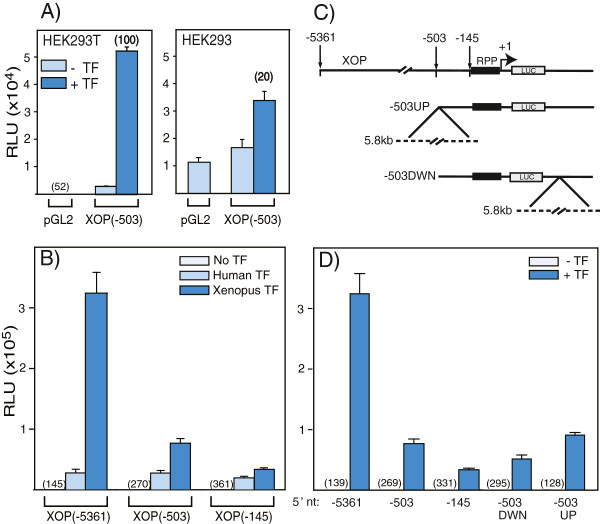Figure 2.
Effect of 5′ flanking sequences on Xenopus rhodopsin promoter activity in transfected 293 cells. (A) Comparison of luciferase activity (relative light units, RLU) from lysates of HEK293 or HEK293T cells transfected with a promoter-less pGL2 or XOP(−503/+41) containing luciferase plasmid in the absence (−TF) or presence (+TF) of pCS2-hCrx and pCS2-hNrl (+TF). The fold stimulation of XOP by hCrx-hNrl is indicated in parentheses. Data are mean ± S.E.M. (n = 2-6) Promoter basal activity (RLU) is shown in parentheses. (B) Comparison of luciferase activity in 293 T cell lysates transfected with plasmids containing different lengths of XOP 5′ US sequence: -5361, -503 and −145 all having the same 3′ sequence at +41. Cells were co-transfected with either human hCrx-hNrl or Xenopus LNrl-Otx5. Data are presented as mean RLU ± S.E.M. (n = 2-6). Promoter basal activity (RLU) is shown in parentheses. (C) Schematic of reporter constructs with additional Xenopus genomic DNA to control for the effect of plasmid size. All plasmids included the rhodopsin proximal promoter (RPP) upstream of the luciferase gene (LUC). XOP (−5361) contained 5.3 kb 5′ US sequence, -503UP and -503DWN contained a 5.8 kb fragment of the rhodopsin structural gene 5′ or 3′ to the RPP, respectively. The dotted line represents the inserted 5.8 kb rhodopsin gene. (D) Comparison of luciferase activity directed by different XOP constructs (−5361/+41, -503/+41, -145/+41, -503UP, -503DWN) in the absence (−TF) or presence (+TF) of Otx5 and L-Nrl. Activities are presented in RLU. The solid line represents the activity of samples transfected with empty pGL2 vector alone. The dotted line is a reference line for XOP(−503) to aid comparison. Data are presented as mean ± S.E.M. (n = 2-12). Promoter basal activity (RLU) is shown in parentheses.

